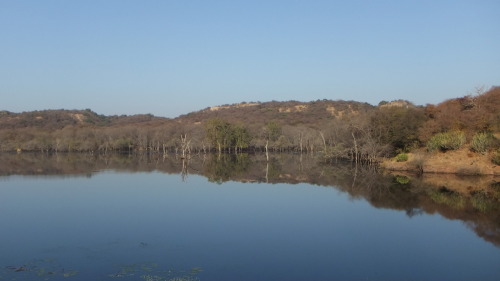Bookmark
The Amazon's Little Tipping Points: Nearing a point of no return?
https://www.reuters.com/investigates/special-report/climate-un-amazon-tipping-point/, posted 2021 by peter in environment nature science
Some scientists fear we are nearing a point of no return in the Amazon rainforest, which exerts power over the carbon cycle like no other terrestrial ecosystem on Earth. Evidence is mounting that in certain areas, localized iterations of irreversible damage may already be happening.
Bookmark
A Renaissance painting reveals how breeding changed watermelons - Vox
https://www.vox.com/2015/7/28/9050469/watermelon-breeding-paintings, posted 2020 by peter in art food history nature
The watermelon originally came from Africa, but after domestication it thrived in hot climates in the Middle East and southern Europe. It probably became common in European gardens and markets around 1600. Old watermelons, like the one in Stanchi's picture, likely tasted pretty good — Nienhuis thinks the sugar content would have been reasonably high, since the melons were eaten fresh and occasionally fermented into wine. But they still looked a lot different.
That's because over time, we've bred watermelons to have the bright red color we recognize today. That fleshy interior is actually the watermelon's placenta, which holds the seeds. Before it was fully domesticated, that placenta lacked the high amounts of lycopene that give it the red color. Through hundreds of years of domestication, we've modified smaller watermelons with a white interior into the larger, lycopene-loaded versions we know today.
Of course, we haven't only changed the color of watermelon. Lately, we've also been experimenting with getting rid of the seeds — which Nienhuis reluctantly calls "the logical progression in domestication." Future generations will at least have photographs to understand what watermelons with seeds looked like. But to see the small, white watermelons of the past, they too will have to look at Renaissance art.
Bookmark
Wood Gas Camp Stove | MAKE
makezine.com/projects/make-27/wood-gas-camp-stove/, posted 2014 by peter in diy energy environment howto nature trekking
There are many designs for efficient stoves, and gasification is only one way to boost the efficiency of a cooking fire. The wood gas stove in this article is an elegantly simple gasifier design called a TLUD stove (for top-lit updraft), also known as an inverted downdraft stove. If you don’t care how it looks, you can build it with a can opener, a punch, and a big rock. This design, which I’ve adapted from one I first saw on Instructables, is built around a 1-quart paint can. It easily boils enough water for a small pot of tea or a bowl of noodles, using nothing more than a fist-sized charge of scrap wood.
Bookmark
Scientists Discover the First Mechanical Gear in Living Creature
www.popularmechanics.com/_mobile/science/environment/the-first-gear-discovered-in-nature-15916433?click=pm_latest, posted 2013 by peter in msm nature science
"As the legs unfurl to power the jump," Burrows says, "both have to move at exactly the same time. If they didn't, the animal would start to spiral out of control." Larger animals, whether kangaroos or NBA players, rely on their nervous system to keep their legs in sync when pushing off to jump—using a constant loop of adjustment and feedback. But for the issus, their legs outpace their nervous system. By the time the insect has sent a signal from its legs to its brain and back again, roughly 5 or 6 milliseconds, the launch has long since happened. Instead, the gears, which engage before the jump, let the issus lock its legs together—synchronizing their movements to a precision of 1/300,000 of a second.
Bookmark
How to avoid getting stung by bees
www.reddit.com/r/funny/comments/ti4ht/not_a_lot_of_people_realize_this/c4mykpf, posted 2012 by peter in health howto nature
I'm a beekeeper who's never been stung by bees (only wasps). We're taught strategies to avoid attracting their attention. Some of them may help reduce the amount you're bothered:
Photoset
Ranthambore National Park, Rajasthan, India
wastholm.tumblr.com/post/13290782828/ranthambore-national-park-rajasthan-india, posted 2011 by peter in asia india nature travel
Bookmark
Who decides what endangered species to save? - Inside Story - Al Jazeera English
english.aljazeera.net/programmes/insidestory/2011/11/2011111085520177376.html?utm_content=automateplus&utm_campaign=Trial6&utm_source=SocialFlow&utm_medium=MasterAccount&utm_term=tweets, posted 2011 by peter in environment nature opinion politics toread video
Is it time to consider shifting efforts away from saving some of the world's most famous species?
It is a controversial proposition and the implications of it are both moral and environmental, but in a recent survey of nearly 600 scientists involved in wildlife protection, around 60 per cent agreed with the idea of shifting efforts away from species that are too difficult or too costly to preserve in the wild.
Many experts have rejected that, saying we have no business making judgements over one species at the expense of another.
Bookmark
Sunflowers no help for decontamination efforts : National : DAILY YOMIURI ONLINE (The Daily Yomiuri)
www.yomiuri.co.jp/dy/national/T110915005208.htm, posted 2011 by peter in environment fukushima japan jpquake msm nature science
Authorities trying to decontaminate radioactive soil in the aftermath of the accident at the Fukushima No. 1 nuclear power plant have found that sunflowers, despite their reputation for absorbing radioactive cesium, have little effect, an experiment has shown.
...
The experiment on removing radioactive cesium started in May in farmland totaling 7,000 square meters in Iitatemura and other locations in Fukushima Prefecture.
In the experiment, the effects of the following four methods were examined: scraping away surface soil; washing contaminated soil with water and removing the water; burying topsoil and replacing it with subsoil; and using sunflowers and other plants to absorb radioactive cesium in soil.
The results showed the least effective of the four methods was the use of plants.



![[photo]](/images/peter_autumn)